Looking for sketchbook ideas? Try nature sketches, botanical studies, travel journaling, food diaries, or creative doodles that break all the rules. Mix in some wild abstract art, dramatic city sketching, or goofy character designs for extra personality. Pattern studies and mixed media experiments can get messy—in a good way! Want something more personal? Track your goals, moods, or positive affirmations. With every page you fill, new creative adventures and awesome inspiration are ready to jump out—and the next surprise is just ahead.
Key Takeaways
- Explore nature sketches and botanical studies by drawing plants, leaves, and animals to enhance observation skills.
- Capture memories through travel journals, illustrated maps, and food diaries that document experiences and favorite meals.
- Experiment with creative doodles and abstract art to reduce stress and unlock spontaneous creative flow.
- Develop character designs and try urban sketching to capture real people, emotions, and dynamic city scenes.
- Combine mixed media, pattern studies, and personal growth pages for unique textures, rhythmic designs, and mindful self-reflection.
Nature Sketches and Botanical Studies
Sometimes, it seems like nature is just begging to be sketched—those twisty tree branches and tiny veins in leaves are almost showing off.
Nature sketches really let artists zoom in on the crazy patterns and awesome textures that plants and animals show off every day. Botanical studies, which focus on drawing plants from life or photos, push artists to pay attention to every detail—leaf shapes, wiggly stems, and delicate petals.
Using tricks like cross-hatching or stippling can make nature sketches pop right off the page, and throwing in watercolors or colored pencils adds even more creative inspiration.
Plus, the more artists sketch, the better they get at seeing those tiny details. It’s all about slowing down, looking closely, and really appreciating the outside world.
Travel Journaling and Illustrated Maps
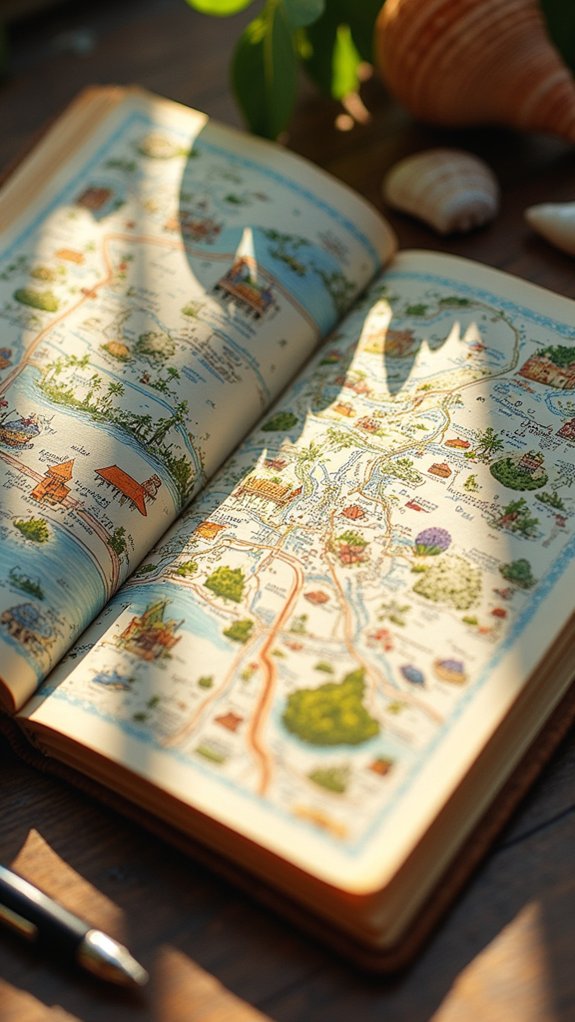
After exploring leaves and branches up close, artists might start to wonder what lies beyond their backyard.
That’s where sketchbook journaling turns every adventure into art. With a travel journal, you can capture memories from a weekend at the beach, a family road trip, or even a stroll through your hometown.
Drawing illustrated maps is an awesome way to record these journeys—you add places you visit, doodle funny landmarks, and scribble in wild stories from the road.
Spaniards even turned their doodles into beautiful travel journals, turning small moments into epic memories.
Sketching while traveling helps you notice details you might’ve missed, deepening your connection to new places.
Plus, travel journaling lets you flex those creativity muscles—sometimes with hilarious results!
30-Day Drawing Challenge Prompts
The 30-day drawing challenge throws out a new prompt every day, pushing artists to think on their feet and get creative with whatever pops up on the list.
Sticking with it can actually turn drawing into a habit—like brushing your teeth, but way more colorful and a lot more fun.
Plus, working through so many different prompts is a sneaky way to level up those art skills without even realizing it!
Daily Prompt Creativity
What if every day could be a burst of fresh creativity? With daily prompt creativity, it totally can! Sketchbook Ideas jump to life when you use your sketchbook for a 30-day drawing challenge. Each day, there’s a quirky prompt—maybe draw your favorite snack, or imagine an underwater city. The magic? You get to twist each one to fit your own style, mood, and favorite techniques. Over a month, these prompts fill the pages with unexpected art adventures, keeping things fresh and never boring. From quick doodles to full-blown masterpieces, you’ll see your skills expand as you experiment and share your wildest creations online. Here’s a peek at five fun daily prompts:
| Day | Drawing Prompt |
|---|---|
| 1 | Robot in pajamas |
| 2 | Magical treehouse |
| 3 | Favorite breakfast |
| 4 | Sneaky ninja cat |
| 5 | Monster under the bed |
Building Consistent Habits
Almost everyone dreams of building better habits, but sticking to something every single day? That’s where things get tricky!
The 30-day drawing challenge takes the idea of building consistency straight into the sketchbook. With a new prompt arriving each day, it keeps things fresh and exciting, almost like opening a tiny creative gift every morning. People can draw anything they like—maybe even sketch their family members posing with funny hats, or doodle the family cat stealing socks.
Expanding Artistic Skills
Once the first few days of a drawing challenge roll by, things start to get really interesting—or should we say, surprising!
Every page of your sketchbook becomes a new adventure. Artists never know if today’s prompt will have them drawing robots, rainstorms, or maybe even a slice of pizza wearing sunglasses.
Now, to really expand those artistic skills, make sure to switch up art supplies when a prompt calls for it—try markers one day and pencils the next.
Exploring different styles and themes can get weird, but that’s half the fun! These challenges help artists push past their “usual” and discover what else their hands can do.
At the end of thirty days, the sketchbook isn’t just full—it’s bursting with creativity and surprises.
Creative Doodles and Freeform Lines
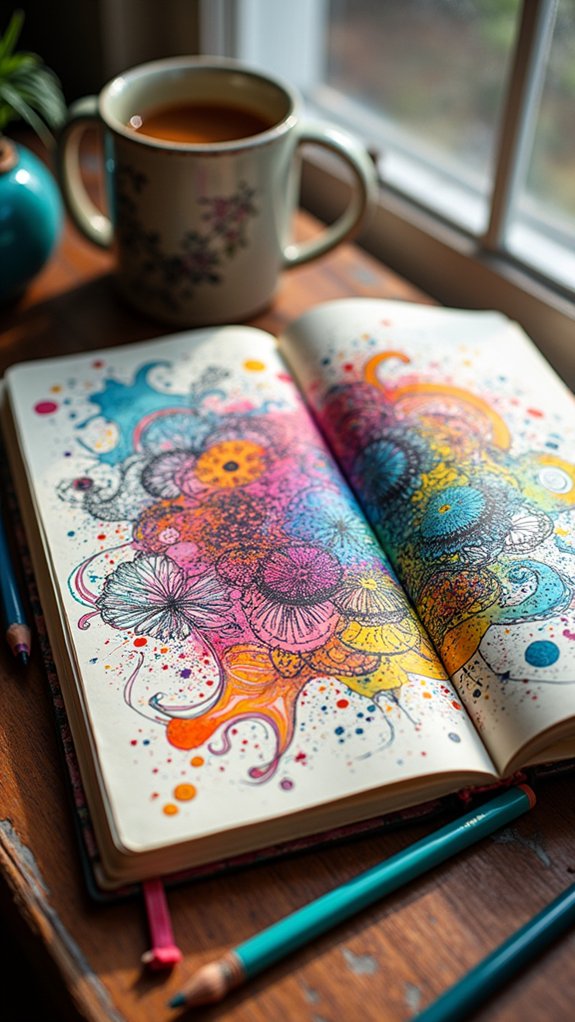
Creative doodles and wild, freeform lines are where sketchbooks start to feel like playgrounds instead of homework.
Artists can explore all sorts of repetitive line patterns, oddball abstract shapes, and even try some totally spontaneous mark-making techniques—kind of like letting your pencil dance across the page however it wants.
There’s no grading, no rules, and sometimes the weirdest squiggle will turn into the coolest idea you’ve had all week!
Exploring Repetitive Line Patterns
Although it might seem simple at first, exploring repetitive line patterns turns a blank sketchbook page into a playground for originality and fun.
When artists grab their pens and draw something with lines heading in every different direction, wild things can happen—zigzags, waves, even spirals! Layering lines thicker or thinner adds a burst of texture and energy, giving your sketch book a lively vibe.
Some people like to fill circles with random lines, creating surprising designs that are way more fun than expected. The best part? There’s no right or wrong way!
Every doodle helps improve your hand-eye coordination, makes your hands steadier, and totally chills your brain. So, the next time you feel stuck, just pick a spot, and let those lines wander.
Abstract Shapes for Relaxation
After messing around with lines that wiggle and zigzag, it’s time for something a little wilder—abstract shapes!
With abstract exploration techniques, anyone can jump into spontaneous doodle practices and turn a blank page into a burst of relaxing shape compositions. There’s no need to chase perfection.
Try making wild shapes with freeform lines, or toss in some circles, squiggles, and blobs—seriously, the more unexpected, the better.
Using thick lines next to thin ones adds drama, like a surprise dance battle in your sketchbook.
Want things calmer? Repeat similar shapes to create a meditative vibe that soothes your mind.
Fill your shapes with spots, crosshatching, or even zigzags for texture. It’s totally cool—everyone’s abstract art turns out unique!
Spontaneous Mark-Making Techniques
Diving right into spontaneous mark-making is a total game-changer for any sketchbook. There’s something wild about picking up a pen and letting your hand wander—no rules, just mark making freedom. This isn’t about careful planning; it’s about creative flow and those happy accidents that make doodling therapy so much fun. By playing with line thickness, direction, and repeating quirky shapes, anyone can turn random squiggles into eye-catching doodles. Plus, using just one pen means way less pressure to be perfect. Practicing these freeform lines every day? That can boost confidence and melt stress. So, if you’re ever stuck or bored, release some unplanned marks and see what happens next!
| Technique | Why Try It? | Level of Fun |
|---|---|---|
| Freeform Lines | Relieves stress | High |
| Repeated Shapes | Builds confidence | Very |
| Varied Thickness | Adds depth and interest | Infinite |
| Daily Practice | Sparks creative flow | Off the charts |
| Single Tool | Reduces pressure | Crazy fun |
Food Diaries and Recipe Illustrations
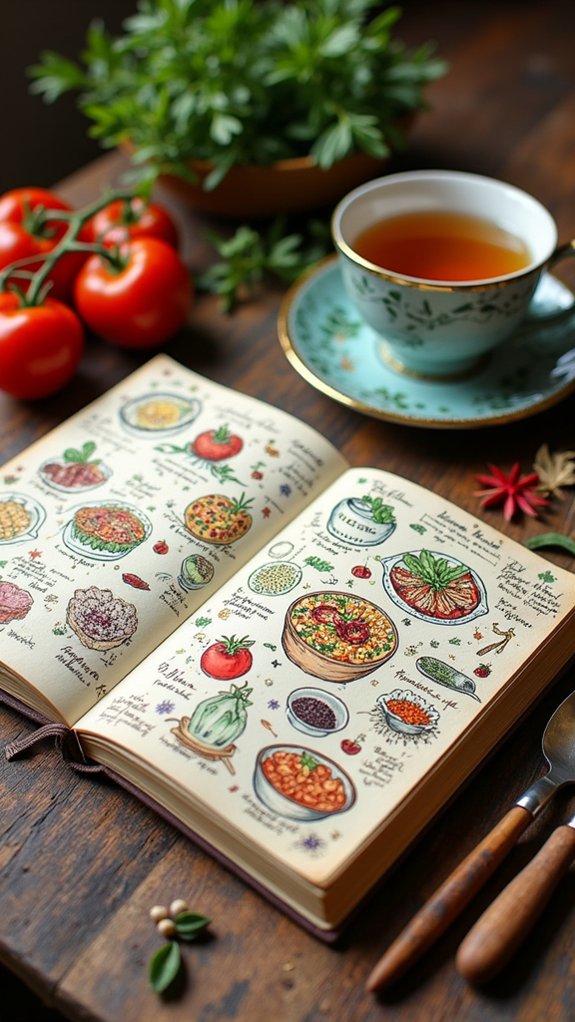
When someone sketches what they eat, it turns an ordinary meal into a mini adventure—like making a sandwich and then drawing it as if it’s about to star in its own movie.
A food diary isn’t just a list of meals; it’s recipe documentation mixed with culinary creativity. By illustrating each dish, people make flavor exploration super fun—imagine drawing spicy tacos, gooey pizza, or frothy matcha lattes in weird colors!
Adding ingredient lists or quick recipe notes beside each doodle helps make these journals useful, too. Playing with watercolors or bold inks brings meals to life right on the page, and if someone travels, sketching local food can be like capturing edible souvenirs.
Who knew art and eating could team up so well?
Character Design and Daily People Sketches
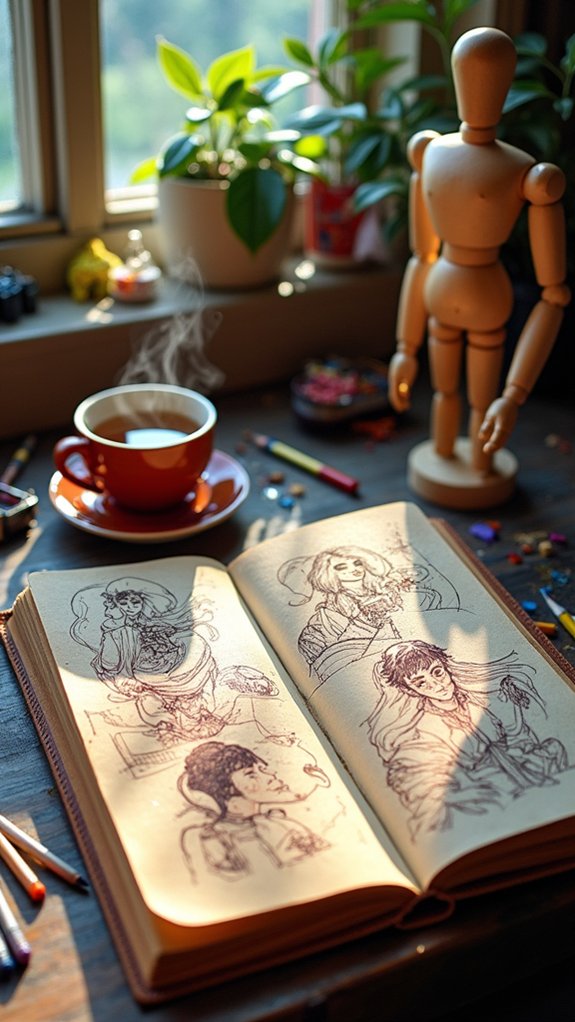
Character design and daily people sketches are like superpowers for artists, letting them capture everyday expressions and all the funny, serious, or wild faces they notice around them.
By playing with different features or wild hairstyles, artists can cook up totally unique characters that stick in your mind—kind of like inventing your own comic book squad.
It’s a mix of practicing real people and making up new ones, all while sharpening observation skills and pushing personal style into new territory.
Capturing Everyday Expressions
Although superheroes and robots look cool, there’s something downright fascinating about regular people just doing everyday stuff—especially their facial expressions.
Sketching humans going about their day is a goldmine for spotting emotional nuance and reading body language. One tiny eyebrow raise, a crooked grin, or even slouched shoulders—those little details say a ton!
Artists often use observational techniques, like people-watching in the park or on a bus, to capture authentic emotions and gestures. Quick sketches can freeze someone mid-laugh or show the stress during finals week (we’ve all been there).
Switching between ink, watercolor, or colored pencils keeps things lively, and adding fun background details can turn sketches into entire stories.
Practice daily, because mastering those sly glances and shy smiles is wicked rewarding!
Developing Unique Character Styles
Ever wondered how some cartoon characters just jump off the page with totally unique personalities? It’s all about using smart character exploration techniques and really paying attention to details.
Sketching real people every day can help boost observation skills—spotting things like slouched shoulders or a dramatic eyebrow raise. Cool, right? Trying out different art tools, like markers or digital apps, makes each drawing pop and brings out personality.
Character sheets are a game changer—they let you play with expressive pose variations and wild outfits, making your character relatable (or totally wacky). To step things up, add a backstory or sketch relationships with other characters.
That’s visual narrative development in action, making every character feel part of an amazing story.
Urban Sketching and Cityscapes
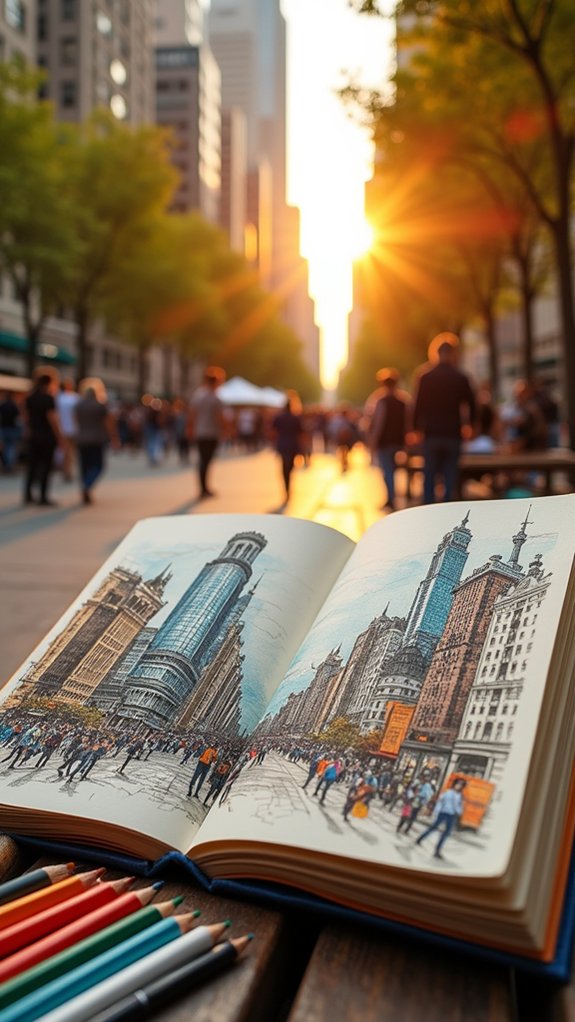
When the city buzzes with life, urban sketching turns that energy into art—like pausing time with a pencil. Urban sketching invites anyone, from beginners to pros, to jump into quick sketches of bustling streets, crowded cafés, or wild city parks.
It’s not about perfect lines but capturing energy on the spot. You might splash in some fun cityscape color palettes or test wild urban sketching techniques—think fast, loose, maybe even a little messy sometimes!
Spontaneous drawing challenges pop up everywhere: catching a cyclist zooming by or nailing that tricky angle on a skyscraper. It’s part observation, part adventure.
- Notice details that others miss—like roof cats or hidden graffiti.
- Dare to mix bold colors for drama.
- Share with sketching friends for extra laughs.
- Sketch fast—blink and you’ll miss the moment!
Collage Art With Scrap Paper and Ephemera
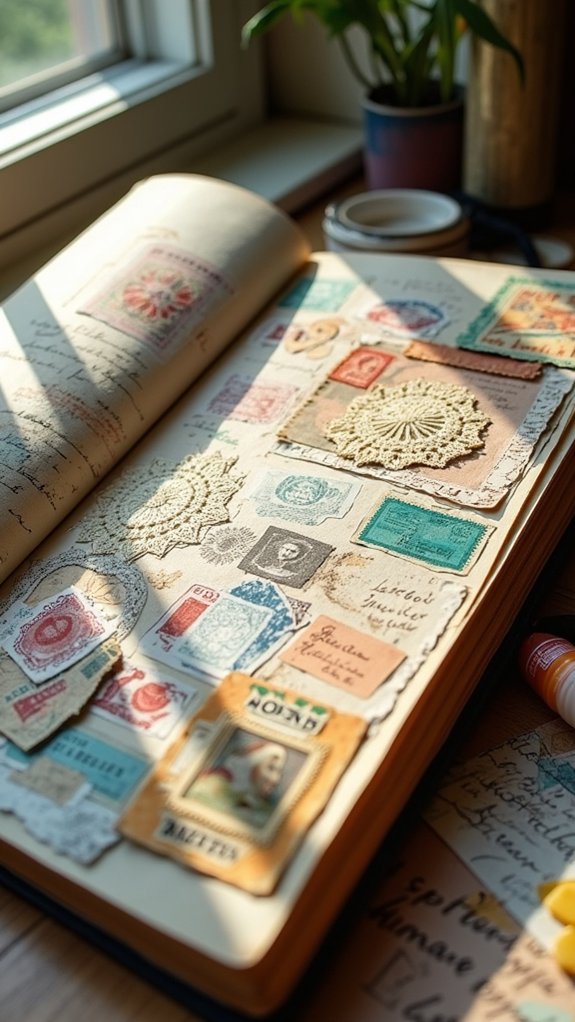
Collage art gets really fun when you start hunting for unexpected materials—think candy wrappers, doodled notes, or even weird receipts you find in your backpack.
Layering these scraps can create wild, textured effects that almost pop off the page, making your sketchbook feel like a secret treasure map.
Mixing the clashing patterns and colors is half the adventure, and sometimes the messier it gets, the cooler it looks.
Sourcing Unique Collage Materials
Although most people walk right past piles of old magazines or used gift wrap without a second glance, artists know that these scraps can spark magic.
With the right eye for material sourcing, everyday items instantly become treasures for collage techniques and wild texture exploration.
Digging through thrift stores or flea markets? That odd postcard or faded ticket stub might just be the missing piece that turns “meh” into “wow” in your journal.
Want something super unique? Toss in pressed flowers or random fabric scraps—suddenly your page has life and stories.
Even experimenting with glue gives you different textures!
- Gather ephemera like old receipts, postcards, or ticket stubs.
- Scavenge for interesting papers and scraps at local thrift shops.
- Press flowers or use fabric for a tactile collage.
- Try assorted adhesives for texture variety.
Layering Techniques for Depth
Dive right in, because layering scrap paper and quirky ephemera is basically the art-world’s version of building a super cool sandwich—each layer adds flavor, personality, and a little surprise.
When it comes to layering strategies, think about grabbing old book pages, candy wrappers, or ticket stubs and arranging them in a way that tells a clever story. Texture exploration is key; rough newspaper next to shiny magazine clippings can make your page pop like an epic selfie.
Play with collage composition by overlapping elements—this creates awesome movement and pulls the viewer’s eye around the artwork. Try tossing in translucent stuff like tissue paper for mysterious, peek-a-boo vibes.
Finish by doodling or painting on top for extra depth. It’s chaos, but in the best way!
Abstract Experiments With Color and Shape
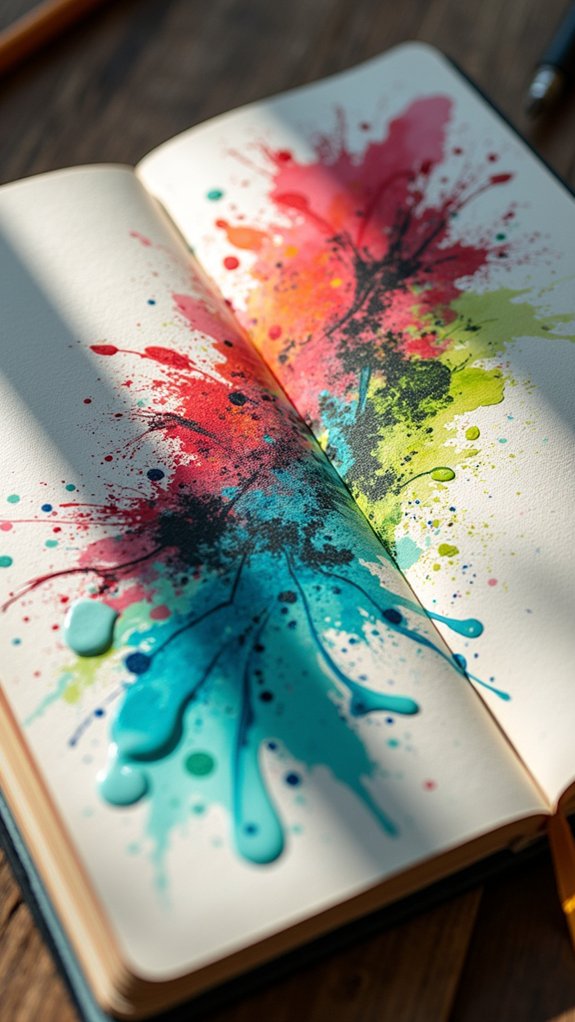
Imagine picking up your sketchbook and deciding, just for today, to let shapes and colors run wild. There are no rules—just grab bold markers, wild watercolors, or whatever you want.
Abstract experiments with color and shape give anyone the freedom to explore ideas way beyond drawing a bowl of fruit or a selfie. Playing with color theory exploration turns each page into a wild science lab; mixing contrasting and matching colors feels a bit like friendly magic.
Shape harmony techniques can transform a mess into something that just feels right. Want to get wild? Try texture experimentation methods—drip, splatter, or even glue in some strange stuff!
- Mix up bold and subtle colors for intense energy or chill vibes.
- Combine geometric and freeform shapes.
- Experiment with layers and textures.
- Add collage pieces for more personality.
Mood Boards and Visual Reflections
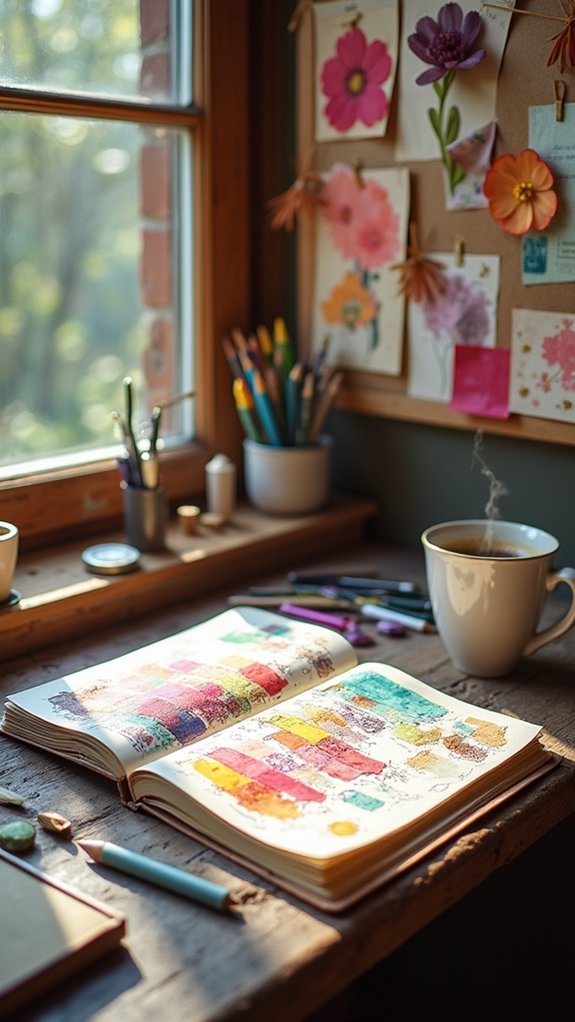
When someone really wants their sketchbook to pop with personality, mood boards are like a supercharged secret weapon.
Think of them as visual collages mixing colors, textures, and cool images—kind of like your brain threw a party on the page! With the right mood board techniques, someone can squeeze a ton of creativity into their sketchbook, using bits of nature, personal photos, and even snippets from favorite artists.
Visual storytelling gets easier when memories and feelings are reflected through images and color symbolism—like using blue for calm days, or red for wild adventures.
Mood boards don’t just look awesome, though—they’re great for setting a clear direction before sketching. Plus, updating them keeps everything fresh, pushing artists to experiment with bold styles and themes.
Hand-Lettering Practice and Typography Art
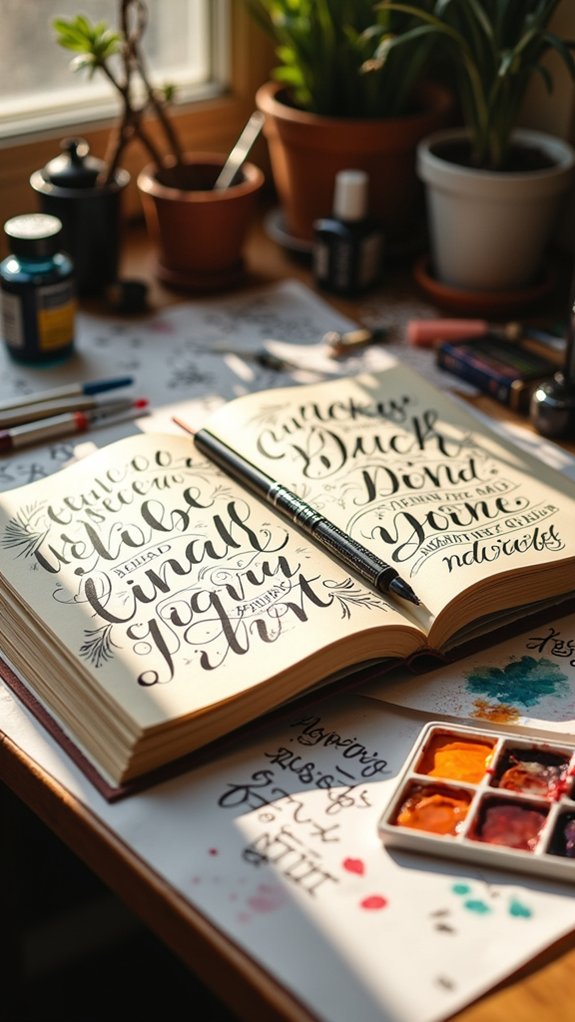
Lettering magic happens right on the page whenever someone starts playing around with hand-lettering and typography art. It’s not just about writing—it’s about turning words into visual art!
With each pen stroke, artists immerse themselves in letterform exploration, making every letter funky, bold, or graceful. Texture experimentation, using brush pens, markers, or even bubble gum (okay, maybe not bubble gum), gives sketches a whole new vibe!
Studying typography inspiration, like cool fonts or snazzy signs, sparks new ideas when you hit a creative block. If someone wants to jump in, here are four things to try:
- Experiment with different tools to create unique textures.
- Play with layouts to enhance word impact.
- Copy favorite fonts for practice.
- Try daily prompts for steady improvement!
Exploring Mixed Media Techniques
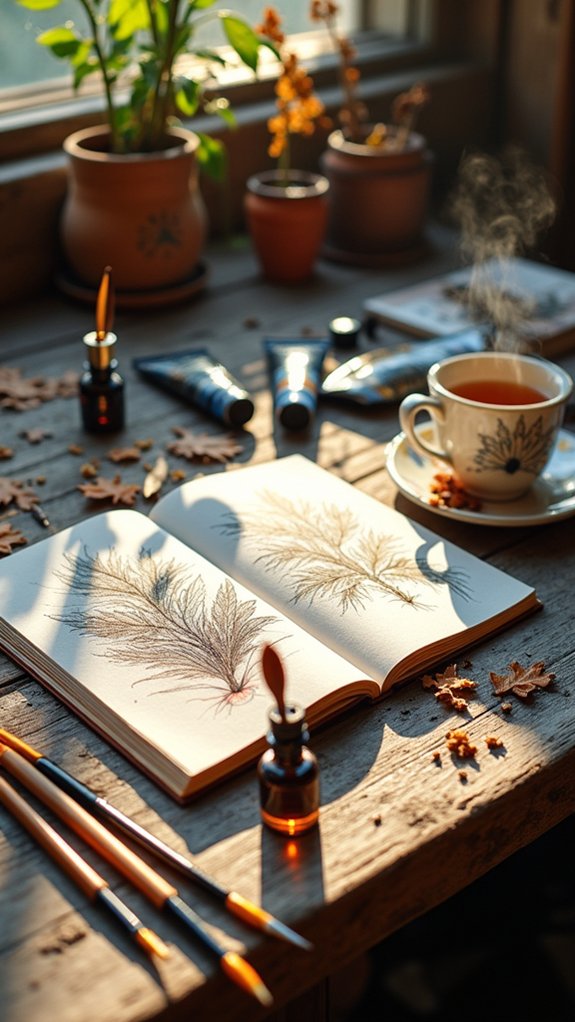
Some sketchbook pages just burst with energy when mixed media techniques get involved.
Imagine painting a wild background with watercolors, then slapping on some acrylic squiggles, and maybe even sticking a ticket stub from your favorite concert right in the middle. That’s layering techniques and found object incorporation working magic together!
The cool part about mixed media is how each material adds something different—textures, colors, even stories.
Texture exploration gets really fun when you bust out gesso for thick, bumpy spots or swipe gel medium on top for a slick, shiny vibe. Stencils and bits of old fabric can sneak in, too!
When artists combine materials like this, their sketchbooks get super creative, full of surprises, and maybe even a little messy—in the best way possible.
Storytelling Through Sequential Art
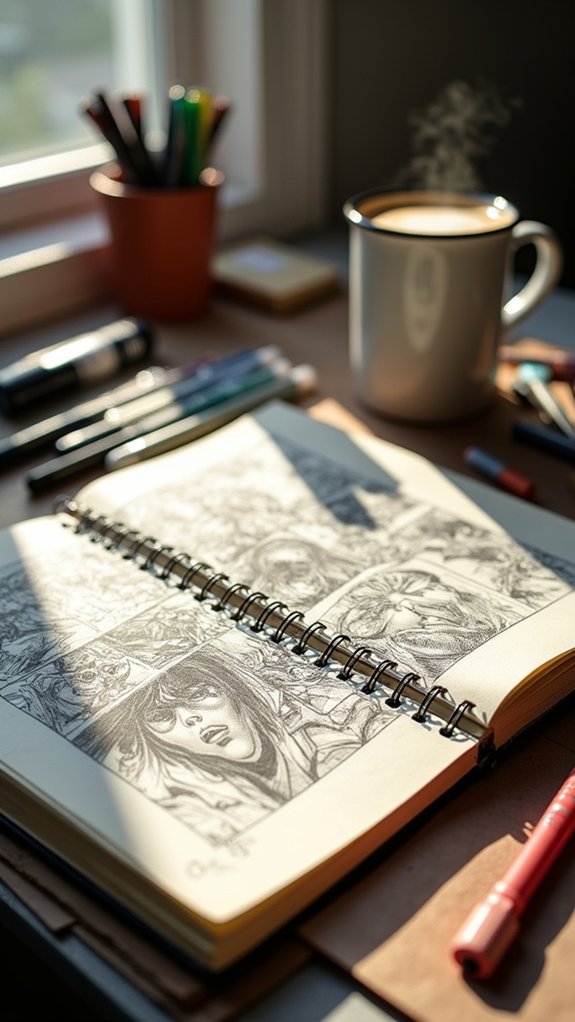
Mixed media really knows how to bring the wow factor, right?
But when it comes to storytelling through sequential art, there’s a whole other level of cool. Artists arrange images in a sequence, kind of like a comic strip or graphic novel, to tell stories with strong visual narrative techniques.
Panel shift dynamics play a huge part—they decide how your eye jumps from one moment to the next, building suspense or delivering a hilarious punchline. Plus, the character expression evolution draws you in by showing emotions shift panel by panel.
Want to dive deeper? Check these out:
- Try switching up layouts—grid versus freeform can totally change the story vibe.
- Focus on body language for plot twists.
- Explore dramatic panel shifts.
- Showcase facial expressions for big emotional moments.
Pattern Studies and Decorative Motifs
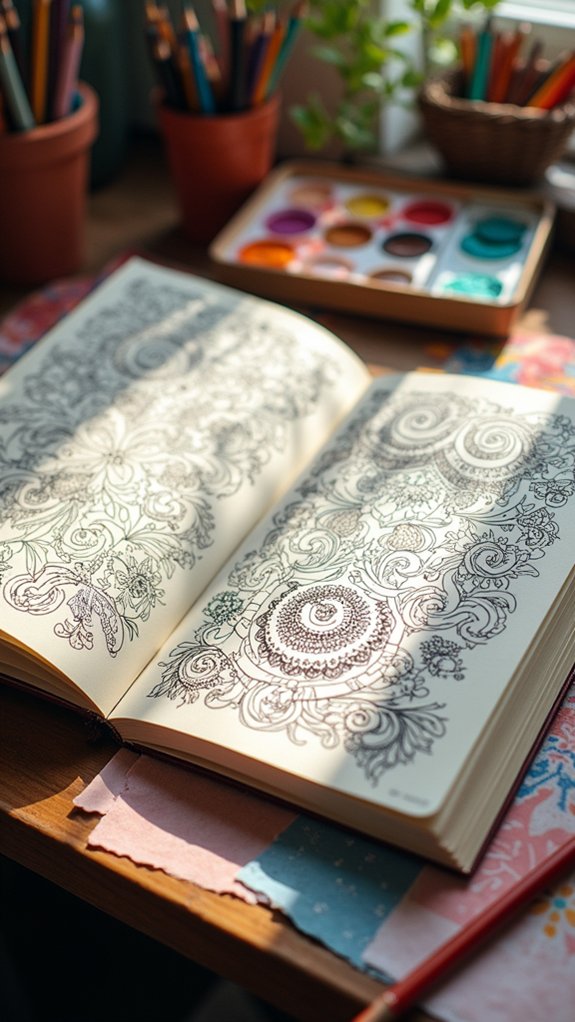
When sketchbook artists immerse themselves in pattern studies and decorative motifs, things can get surprisingly mesmerizing—almost as if the page starts to groove with its own beat. Doodles stack up: lines, swirls, squares, even that weird spiral you drew once by accident.
By playing with pattern evolution techniques, artists can see how one zigzag leads to a whole maze of designs. Geometric shape adaptations come in handy, too—a plain triangle can quickly morph into a whole tessellated masterpiece.
Cultural motif exploration makes things extra interesting, borrowing ideas from nature or different traditions. Sometimes, a splash of watercolor or some scratchy ink lines bring the patterns to life.
Basically, these studies help boost skills, spark creativity, and make the sketchbook feel a lot less boring.
Personal Growth Pages and Affirmation Art
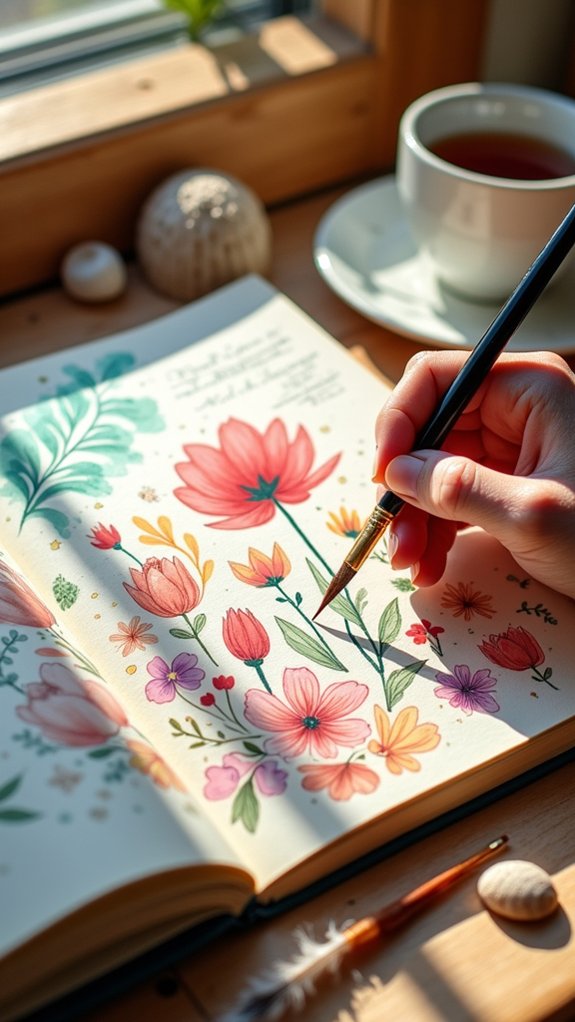
Everyone needs a little boost now and then, and that’s exactly where personal growth pages and affirmation art come into play. These sketchbook pages can be super helpful—not just for drawing, but for shaping the way someone thinks and feels.
Self reflection prompts help people check in with themselves when things get messy, while goal setting techniques make big dreams more manageable, step by step. Add mindfulness practices to the mix, and suddenly, a journal becomes a secret weapon for confidence and calm.
With vibrant watercolor, cool hand lettering, or wild mixed media, affirmation art shouts positive vibes every time a page flips.
- Self reflection prompts spark honest conversations with yourself.
- Goal setting techniques turn ideas into achievable plans.
- Mindfulness practices encourage calm, focused thinking.
- Affirmation art boosts confidence with every glance.
Frequently Asked Questions
How Do I Overcome Creative Block When Starting a New Sketchbook?
Overcoming creative block when starting a new sketchbook can involve employing brainstorming techniques, utilizing sketch prompts, and engaging in creative exercises. These methods encourage fresh ideas, reduce the pressure of perfection, and help spark inspiration for artistic exploration.
What Are Some Tips for Maintaining a Consistent Journaling Routine?
To maintain a consistent journaling routine, one may utilize journaling prompts for inspiration, implement structured time management to designate regular writing periods, and employ habit tracking methods to monitor progress and reinforce the journaling habit over time.
How Can I Choose the Best Sketchbook or Paper for My Needs?
Selecting the best sketchbook or paper depends on evaluating paper types for texture and weight, considering sketchbook sizes for portability or workspace, and exploring binding options such as spiral, hardcover, or stitched to suit personal artistic preferences.
What Tools Should Beginners Use When Starting a Visual Journal?
Beginners are advised to use basic art supplies, such as pencils, erasers, and pens, to experiment with various sketching techniques. Creative prompts can inspire exploration and development of personal style while building foundational skills in a visual journal.
How Do I Organize and Store Completed Sketchbooks Effectively?
To organize and store completed sketchbooks effectively, individuals may use dedicated sketchbook shelving for easy access, implement archival storage for preservation, and create a digital cataloging system to track content, dates, and relevant details for future reference.
Conclusion
With all these sketchbook ideas, no page ever has to feel empty or boring again! Whether someone’s doodling a dinosaur eating pizza or drawing a magical forest, there’s always something new to try. It’s totally fine if things get messy—sometimes that’s when the coolest creations happen. The most important thing? Keep going, have fun, and don’t worry about “perfect.” After all, every great artist started with just one blank page, just like this.

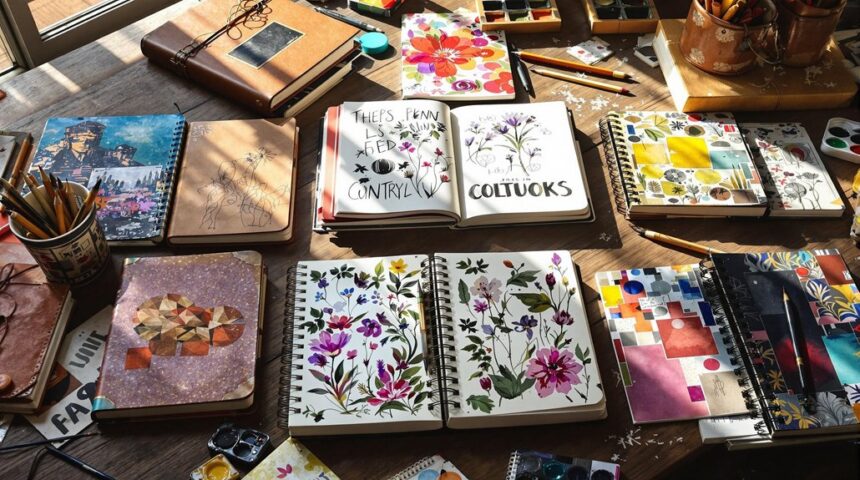
Leave a Reply